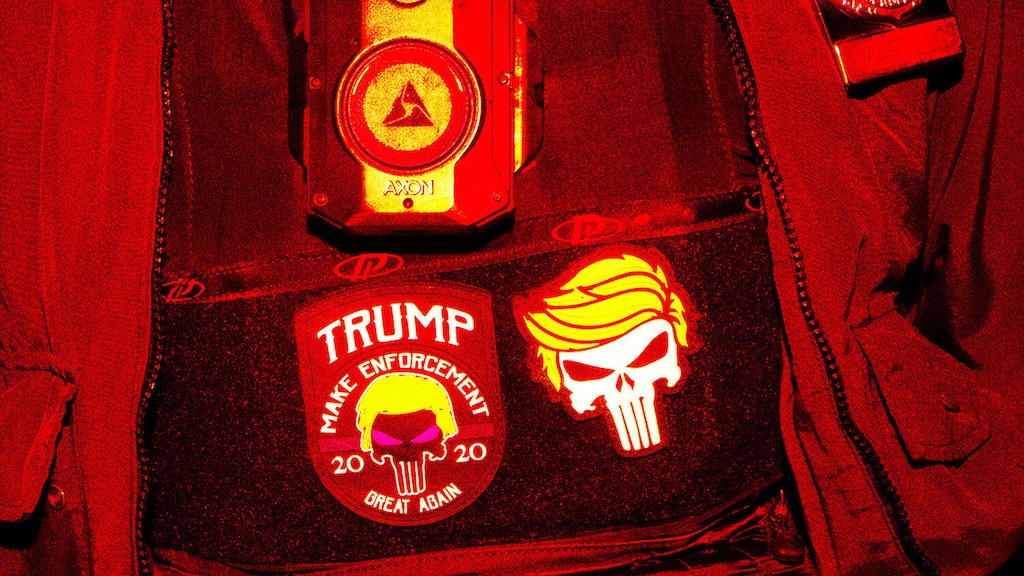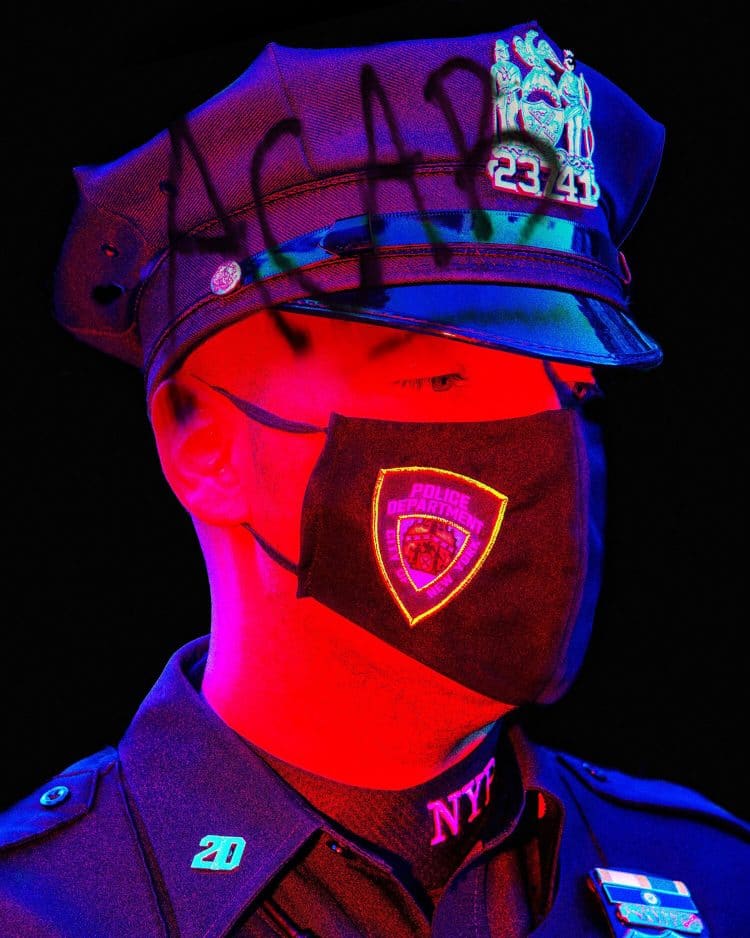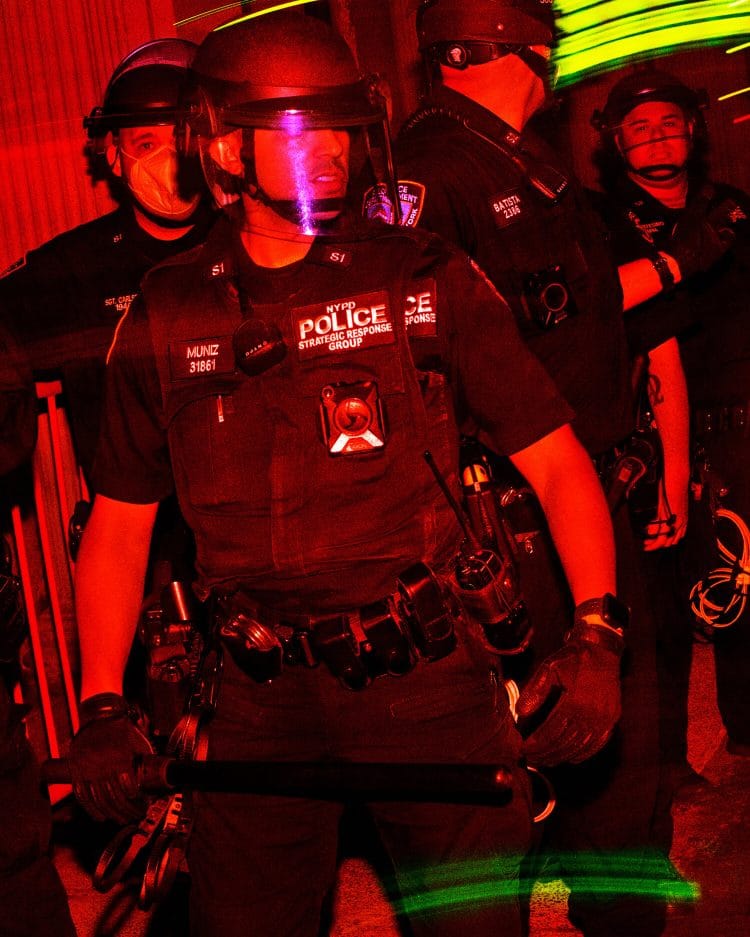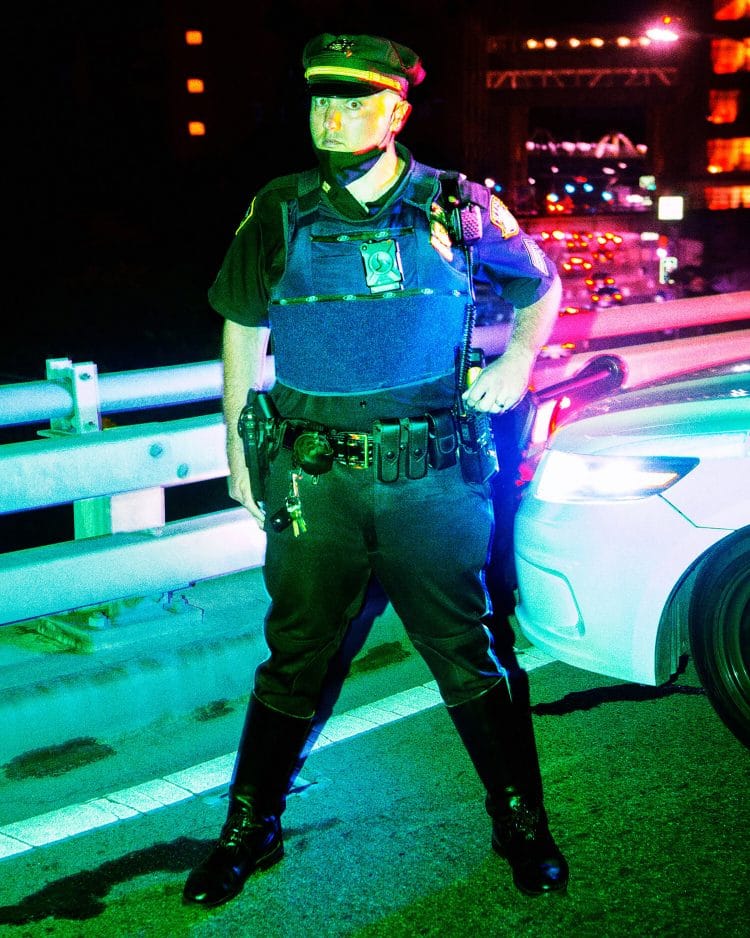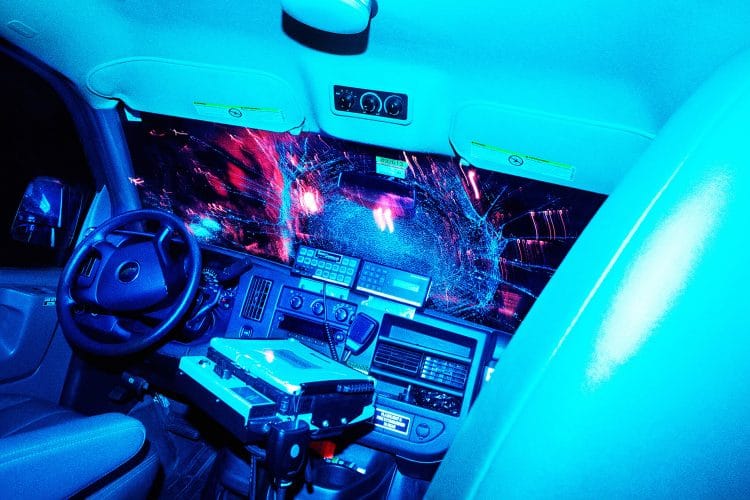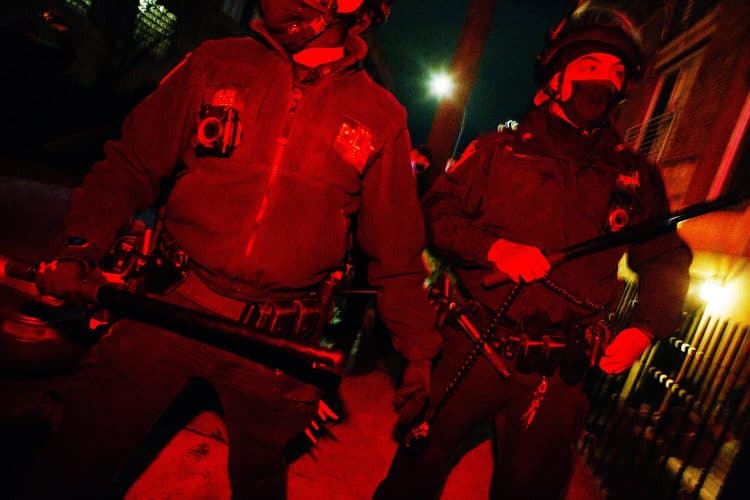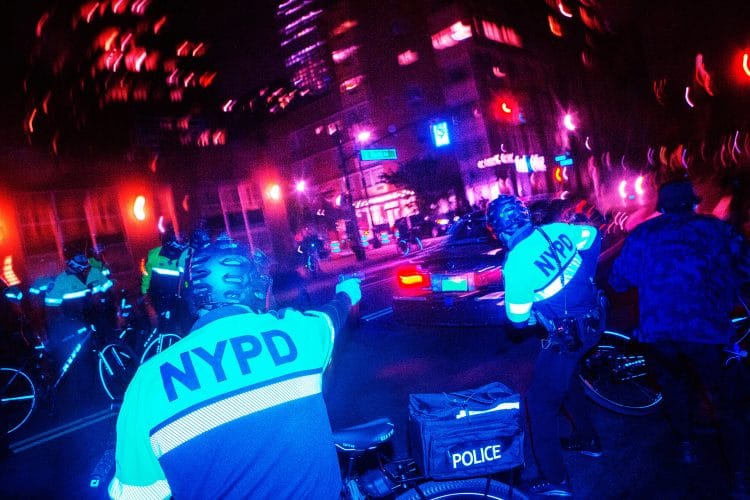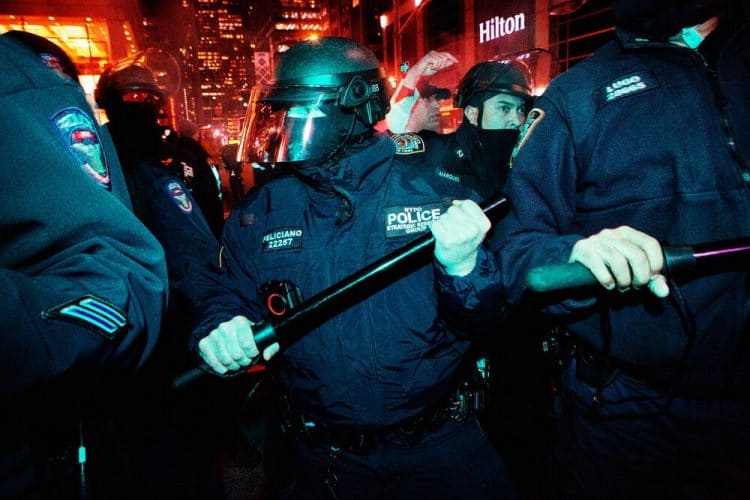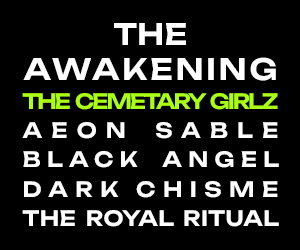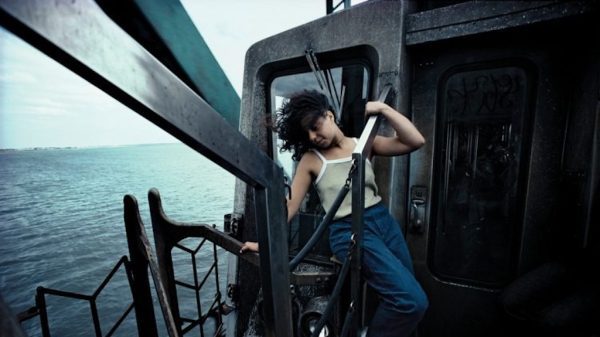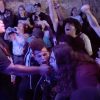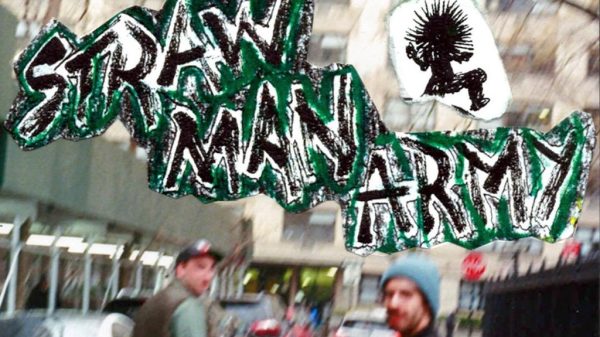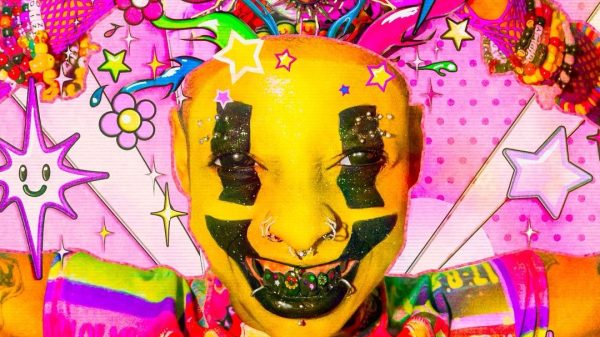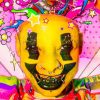How did your 1312 series start? Did you plan to go out and shoot cops (lol) or did the series form out of photographing rallies?
I was photographing music in Brooklyn pretty steadily up until the beginning of the pandemic and then ended up spending time in my hometown, Rochester, NY. When George Floyd was murdered and protests broke out around the country, I started attending protests immediately but never brought my camera to any actions in Rochester.
After giving it a lot of thought during those months as a protestor, I decided to start photographing the police when I returned to NYC. I saw tons of amazing photographers turn their cameras toward protesters to capture the faces of people standing up to state power but I felt the police themselves were a less explored topic and a subject matter my work is suited for. Plus, I wouldn’t be putting any protestors at risk if I made a rule for myself to shoot (lol) “cops not comrades.”
My experience photographing hectic punk shows, mosh pits, etc.. informs how I shoot at protests, specifically in terms of being close to police lines. Most importantly, I conceived of this project as a way to examine the outward expressions of state power and question the ways in which we as people (especially photographers and journalists) are taught to document it. From the beginning of the project, I have made a conscious decision to use my colored flash as a definitive statement of perspective and made a point to separate myself from “Press.” I very much intend to be a protester first, photographer second.
How did cops react to you taking their portraits?
I get all sorts of reactions depending on the cop—often they will make jokes or smile. Others will blatantly ignore me, and others respond with aggression or anger. Really depends on individual personality but also the overall level of tension in the situation. Lots of cheesy jokes about getting a good shot. Lots of stone-faced stares in moments of impending conflict.
The name 1312 infers you think All Cops Are Bastards. Do you, and if so, why?
I really do believe in the possibility of a world without police, and I believe police, as we have them now, represent above all else the interests of the state and capital. They are fundamentally anti-worker and anti-labor. And of course, these systems themselves are built upon, reinforce, and maintain racial inequality—meaning policing within modern capitalism is inherently racist as well. I kinda think anyone willing to enter into that system and wield state power against the people just might be a bastard. The real point, though, is that the act of being a cop requires an otherwise well-intentioned or good person to be a bastard.
Excuse my Canadian ignorance, but there’s a photo you took of a cop wearing patches of the Punisher Skull wearing Trump’s toupee with the slogan “Make Enforcement Great Again.” Is that for fucking real? That cop actually thought a toupee-wearing skull would make him look great? Why?
I mean, Trump is idolized in a such specific way, so the symbols that come out of that are sometimes fucking wild and just plain weird. The Punisher logo itself is so prevalent among law enforcement and this is extremely troubling. It is essentially a symbol saying cops believe they are above the laws they are (supposedly) upholding. It sends a message that they are willing to use violence to maintain the order they see fit and act outside the constraints of the law. (FYI, the cop in the photo you’re referencing is Sgt. Dana M. Martillo. She has 10 allegations made against her according to https://www.50-a.org/ — which is an excellent resource.)
There’s another cop wearing gloves with #WAR across the knuckles. Do NYPD officers typically wear a lot of this kind of fascist flair?
I would say there is some confirmation bias, because of course, I am selecting images in my edit that show this sort of thing. So I would not say your average cop necessarily wears this sort of stuff on a day-to-day basis, although many do. If you look, all sorts of symbols show up. Like I said above, the Punisher logo has become an accepted symbol within law enforcement, and the Blue Line flag is pretty much ubiquitous.
Also, it is important to keep in mind that many of the police I photograph are police specifically called to engage with protests. In NYC, this is usually the SRG (Strategic Response Group). They may not always be present from the beginning of an action, but they are the ones who always show up for crowd control and arrests equipped with riot gear, etc. They tend to be more aggressive, more ideological, and inherently view their presence as an oppositional force. So flair and little fascist touches would be more normalized among this group. I don’t mean to imply fascist symbolism isn’t prevalent throughout the entire force, though — more and more, symbols are being used by police departments to wage an ideological war across the country.
I lived briefly in NYC, and from the short time I was there, my perception of the NYPD is that they are the least professional police force I’d ever encountered. They made the LAPD look good. I was followed and sexually harassed by male NYPD officers multiple times in just a few months. I witnessed them smoking on the job, morbidly obese officers who couldn’t chase a suspect if their life depended on it, rampant racial profiling, and officers just being general shitty humans. They were a big reason I didn’t want to live there. What’s your opinion on why NYPD officers are so entitled to be terrible people?
I think this is a really complicated question that has a lot of factors. Most of my experience with police has been in NYC so I don’t necessarily feel equipped to compare them to other large city police forces. I do think what you are saying is largely true though. I imagine it has to do with the sheer size of the NYPD, the massive budget, a huge lack of oversight, and also the way the NYPD interacts with the citizens. I think the size of the force and relative safety of being a cop in NYC attracts a lot of people who don’t actually care all that much about the job and want to collect overtime, etc. I think NYC being a densely populated city that is less centered around cars plays a huge role in what you’ve experienced as well. The cops are regularly on foot, in close contact with the people, and entrenched in the subway systems. So they are more visible, their behavior is more readily apparent, and they have more direct (negative) interactions with people.
Outside the context of protests, it is clear to me that officers often don’t really give a shit and are incentivized to be lazy and abusive through a clear lack of oversight. Many cops know if they get disciplined or written up, likely nothing will happen and worst case they will just be transferred to a different precinct.
Tell me about the color scheme you chose for this project.
Aesthetically, this is a style I developed through shooting punk shows and raves but thematically, it represents something different and integral for this project. As I mentioned earlier, in the streets, I am a protester first, photographer second. A photograph acts as a verb and action whether I intend it to or not, so I’d rather harness that and make it purposeful. There is a further conversation to be had about photojournalists and how they cover protests. I believe objectivity is not possible, an image serves propaganda well and if someone is working for a corporation — even on a freelance basis — they are giving up editorial control of their own images.
My use of color serves as an immediate statement of my perspective, and by using my own creative vision, I hope to question the accepted ways in which we are taught to photograph protests, especially the police. When I shoot, I get close, I aggressively use my flash, and I present myself as a protester. I aim to break down the barriers that traditional journalists face while documenting political action. This allows me to show the police when they feel vulnerable, examined, or confronted. It also allows me to take actions other photographers often do not, because I am not bound by someone else’s set of rules and neither is the work I create. There may be a time and place for attempting some level of objectivity but I don’t work for anyone when I am photographing protests, don’t consider myself a photojournalist or a member of the press in this context, and am not beholden to their rules. For me, the use of color and a pronounced aesthetic makes this clear.
A lot of your photos document so-called “vandalism,” broken windows, protest graffiti, etc. and you also have photos of the cops looking like they’re smashing a car window. What’s the contrast you’re demonstrating between civilian frustration and militarized police?
These images are important to me because I don’t want people to forget that there is an intensely physical aspect to all of this. Property damage is a direct political expression, whether people are comfortable with it or not. What we’ve seen already and what will continue to happen with greater frequency is a direct conflict between the people and state power. This conflict is between the people and a racist institution. Banks are part of it. Corporations are part of it. Our cultural concepts of private property support oppressive systems. As climate battles ramp up and inequality worsens, protests will increasingly come into direct conflict with our conceptions of private property — this is only natural and inevitable.
Also — the cops are violent. The point of police is that they are legally allowed to use violence. Their tools are weapons. And they will use this violence. All the pageantry and militarization of police forces tends to hide the reality of violence, which is that it is messy as all hell.
In the same vein, on some of your cop portraits, you’ve superimposed anti-cop graffiti. Talk to us about your idea behind those.
This is something I’d love to do more of. I want to continue the idea that my work has a perspective through more multimedia experiments, and present the conflict between protestors and police explicitly. I feel this has the potential to touch on the ideological conflicts involving our concepts of private property and state power. Political graffiti has power and that power is, in my opinion, often rooted in a sort of symbolic reclaiming of the commons. The police are there to make sure we cannot even reclaim the commons symbolically.
I’m seeing a lot of phallic imagery, cops gripping their “batons” at crotch level. Are you drawing a line between insecure masculinity and law enforcement with these photos?
This wasn’t intentional at first but it definitely became an element in the project over time. Mostly due to the cops’ behavior! A lot of these images came about because I was trying to capture the depersonalized nature of the equipment and weapons cops carry. They have often commented on me “photographing their crotches” as a way to make light and make fun of me. Which of course encourages me because I think it’s funny. The jokes the cops make out of discomfort are often really telling and are directly in line with their insecurities!
Many of the cop portraits reek of fear and insecurity. Many of them look terrified, despite being armed and armored to the teeth facing a group of unarmed civilians. Was that something you intended to catch on film, or was it something you discovered after looking at the pictures?
A militarized force can and will view the public as opposition. Popular dissent is usually seen by officers as a dangerous threat or as naive and frivolous. In my opinion, many officers don’t really understand what is going on. They don’t understand why they are being targeted, they don’t understand the motivations and ideology behind many opposition movements and this scares them. I think this confusion encourages reactions of fear and anger.
I find that the higher-ranking officers do understand — but they are the ones ideologically opposed to protest and the rights of the public to speak up. I get the sense that the lower-ranking officers who do understand are often just exhausted and do not want to be there. These are all things I have learned through direct experience — both as a protestor and photographer. I remember one protest in particular: there were roughly 300 officers in the area, forming lines and phalanxes in riot gear, in response to a protest involving about 50 people. Despite this, many of the well-armed officers still seemed terrified.
I see a lot of names and badge numbers in this series, almost like you’re documenting perpetrators of potential human rights abuse — is it intentional to have the officer’s name and badge number in sharp relief in these portraits?
This wasn’t one of my main intentions — there are organized community groups who do CopWatch patrols to specifically collect and document this information, and they do an excellent job. However, it is definitely an added benefit to getting as close as I get. I am always happy to provide names and badge number info to people, especially if there are violent incidents or arrests involving officers.
Along those same lines, the names and badge numbers are the only differentiator between these otherwise masked-up and geared-up cops. How do you see the juxtaposition between their dehumanizing uniforms and the small patch that indicates their humanity?
When protests were at their peak, there was definitely a trend among officers to purposely hide or obscure batch numbers and identifying features. Beyond the legal ramifications of this, I think it is helpful to the state to have police opposition to protests feel like an impersonal force. Often riot gear, batons, etc. aren’t even used but serve as intimidation. The depersonalization of protest cops is definitely a strategy and a factor in how intimidation is used to suppress dissent. Not to mention, cops will feel more emboldened to ignore protocol or act impulsively if they feel they can’t be identified.
How do you see the intersection between policing, slavery, the destruction of generational wealth in racialized communities, housing segregation/redlining, underfunded Black and Brown schools, and the prison industrial complex reflected in our communities today? What solutions appeal to you?
All of the issues you mention are intertwined and displayed in the inequalities we see in society. Financialization, debt society, the school to prison pipeline — all of these form a modern capitalist version of indentured servitude and criminalize poverty through debt and imprisonment. You can see this clearly through the racial, identity, and class-based enforcement of access. Access to resources, access to education, access to living spaces, and the extreme loss of all access through imprisonment.
Police are the violent foot soldiers of capital that the state uses to maintain this social order. I think we will increasingly see struggles that challenge people’s perspectives of class and state power. How will labor movements reach solidarity across racial lines when the police come to exert corporate violence, for example? How will movements foster solidarity when the aim of the state is to enforce separations?
I think all of this is, at its heart, a conflict (capital maintaining racial and other hierarchies through class warfare and the “justice” system) and that people will need to awaken on their own terms through struggle. There is a long history of radical knowledge and this must be discovered and rediscovered. For many people, this will require a rejection of privileges and comforts and an embrace of solidarity and struggle on a personal level. I think an education on capitalism and how it functions along racial lines kind of requires this personal shift within an individual. It requires either this shift or a rejection of these ideas as a whole — which is the difference between an embrace of liberation vs. a retreat into conservative and reactionary thought.
Maybe you already answered this in the previous question — but abolish or defund, and why?
Abolish — but I do not think the two are mutually exclusive. One potential path towards abolition would involve re-directing police funds to community support networks while simultaneously creating community oversight power over police forces. This would include the power to fire officers and directly impose the will of the people over the police that are active in a local community. So defunding as a broad idea opens up many pathways to abolition and helps create the support networks that would be a necessary precedent for any world without police.
At the very least, there is no way out of the current policing situation without the de-militarization of police. As long as police have weapons of war, they will use them, and they will use them against the disempowered.
So broadly, I think defunding, and all the refunding of support networks that goes implicitly with it, can help towards the path of abolition. And in the meantime, state violence should be opposed on every front and direct action as a practice should be central to this, as well as directly linked networks of mutual aid.
What do you want the viewer to take away from this series? What discussion are you trying to spark?
Ideally, I would like to propose a set of questions:
What is the role of photographers and journalists within protest/documenting civil unrest? Must we remain impartial? How does the claimed “objectivity” of established media practices uphold the status quo of state power?
How do police represent, embody, and enact state power? What are the symbols used by police? What does the police response to protest movements say about the perspective of the state re: political movements and opposition?
What is it like to directly confront state power? What set of violence is represented? What can we learn about the relationship between police and citizens? Specifically police and protestors?

